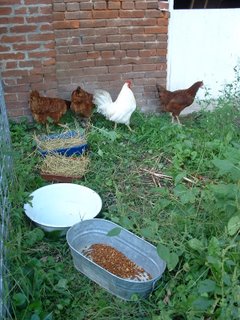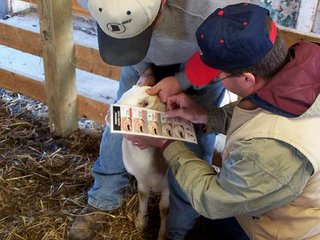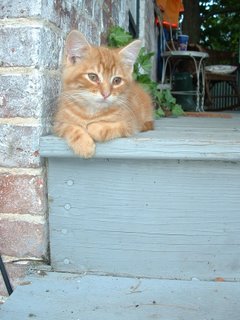 Ginger is checking out the bizarre new creatures in her space.
Ginger is checking out the bizarre new creatures in her space.My name is Jeanne. For years, I had dreamed of living on a farm in the country and being a dairy goat farmer and cheesemaker. Now that I've moved into a 130-year old home, complete with it's own mill, in the country and rounded up some dairy goats, I plan to chronicle my life learning how to live with nature, with various critters, and all the amenities of rural life on two acres down in the valley. Come take a look-see.
Tuesday, September 19, 2006
Bok! Bok!
 Ginger is checking out the bizarre new creatures in her space.
Ginger is checking out the bizarre new creatures in her space.Friday, September 15, 2006
Barn Work
 John got busy last weekend in the barn. Among many small jobs, he built this free-standing hay feeder. The lid on top is removable to place the bale right in. When the goats approached the feeder the first time, they became obsessed with removing the lid. They couldn't stop messing with it until they worked it off the base. When the lid was finally down, they got back to the business of eating hay. Now we keep it off to avoid injuries to the goats when it falls down. The lid is now used as a toy. The girls love to walk on it. They always knock over the feeder too. John is going to have to add boards to the bottom to keep it from tipping over.
John got busy last weekend in the barn. Among many small jobs, he built this free-standing hay feeder. The lid on top is removable to place the bale right in. When the goats approached the feeder the first time, they became obsessed with removing the lid. They couldn't stop messing with it until they worked it off the base. When the lid was finally down, they got back to the business of eating hay. Now we keep it off to avoid injuries to the goats when it falls down. The lid is now used as a toy. The girls love to walk on it. They always knock over the feeder too. John is going to have to add boards to the bottom to keep it from tipping over.

John attached a hinged piece of fencing panel to this side-door to allow us to keep the door open for ventilation without allowing the goats into the feed area of the barn. Again, not beautiful, but it works.
Sunday, September 10, 2006
York Fair
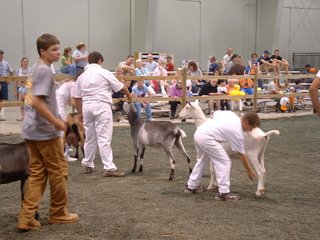
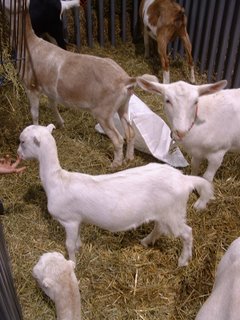
When you look at these goats up close, you can see that they've been clipped. They look nice that way. It looked like some were even wearing some type of gloss in their coats. I was also sizing up the different hays that the different breeders were offering their goats. There was quite a variance. John and I got some good ideas for our own goats too.

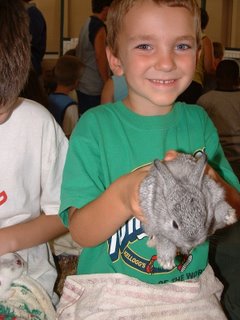 Asa really loved this bunny. All of the animals were so docile, none of them even tried to step down from the kid's laps. When mom and dad had stood around waiting long enough, we moved on to the games. Jake and Asa fished for sharks, squirted water guns, and threw darts at balloons. We had dinner, went back to the petting zoo for a second visit, then had ice cream for dessert. We were all tired and ready to go home. We had a great time visiting other goats and enjoying lots of different animals. Jake kept saying that we should bring our goats to show and that he thought that they'd win. John and I took that opportunity to tell him that perhaps he could join 4-H or some kids goat group and raise a show goat himself. His eyes lit up and seemed very interested in the prospect. So, that's what we'll do... look into finding him a kids goat club.
Asa really loved this bunny. All of the animals were so docile, none of them even tried to step down from the kid's laps. When mom and dad had stood around waiting long enough, we moved on to the games. Jake and Asa fished for sharks, squirted water guns, and threw darts at balloons. We had dinner, went back to the petting zoo for a second visit, then had ice cream for dessert. We were all tired and ready to go home. We had a great time visiting other goats and enjoying lots of different animals. Jake kept saying that we should bring our goats to show and that he thought that they'd win. John and I took that opportunity to tell him that perhaps he could join 4-H or some kids goat group and raise a show goat himself. His eyes lit up and seemed very interested in the prospect. So, that's what we'll do... look into finding him a kids goat club.
Thursday, September 07, 2006
I am now FAMACHA Certified!
This field day was designed to help producers develop integrated parasite management (IPM) programs for their farms and flocks. In addition to teaching the basics of internal parasites and their control, the workshop teaches proper anthelmintic use and provide hands-on training in doing fecal egg analyses and using the FAMACHA© Eye Anemia Guide to determine the need for deworming individual animals.
This class was really informative and the instructor, Susan Schoenian, was great. She was very knowledgable and funny too. She made the class fun and interesting; I feel like I really got a lot of solid information from her. I also met some interesting small-ruminant folks.
Monday, September 04, 2006
Hands-On Small Ruminant Care
This intensive hands-on workshop will be limited to 20 participants and will feature four sessions: Hoof Care and Trimming, Kidding and Calving, Necropsy, and Nutrition. The session on "hoof care and trimming" will include a discussion on hoof architecture and common problems, followed by a trimming demonstration and hands-on practice. Using a simulation set-up, every participant will then have the opportunity to participate in a birthing simulation, which will prepare the novice for handling complications during the birthing process. In the afternoon, a necropsy will be performed with the aim of empowering participates with a deeper understanding of the cause of animal loss and the affects of disease and parasitic infections. Based on the necropsy findings, participants will be able to strategize proactive solutions to minimize risk on their farms in the future. The nutrition discussion will include tips for preventing disease and participants will learn how to discern the qualities of different types of feed, hay, and forages.
Earnest Hovingh, DVM, PhD, specializes in herd/population evaluations for health issues, a "Master Hoof Trimmer", and advocate of whole farm evaluations to determine weak links in animal care and animal welfare.
Robert Van Saun, DVM PhD, specializes in small ruminant pregnancy nutrition and its influence on health, production and reproduction; metabolic diseases and their prevention; and preventive medicine programs.
David Wolfgang, VMD, specializes in disease prevention and herd health promotion, cost effective delivery of veterinary services to producers and farm-based improvements to herd health.
Then on Wednesday, I'll be taking another field day class: FAMACHA Certification. I'll explain that one in another post. In late October, John and I will take a class together: Home Cheesemaking with Ricki Carroll. This class I am particularly thrilled about!
Saturday, September 02, 2006
Hello Barncats
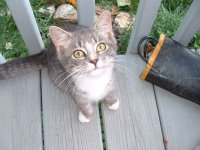

Millie had a rough first day: shortly after plunking her down in her new digs, she decided to explore the hole in the ground at the base of the mill wall, and I ended up having to climb down there to get her out. Under our flour mill is the partially-filled mill race. Partially filled with bricks, dirt, and debris; partially filled with water. At some point in time, folks used the mill race as a dump.

You can find the oddest (creepiest) objects in the water down there. From the sloping mud and broken bricks down into the water you can see a child's plastic ball floating on blackness, on broken bricks - a lightbulb (fully intact - how can that be?), some tires, a push-mower, metal gas cans, glass gallon jugs - some broken, some not; cinderblocks, overturned metal 5-gallon buckets without lids and oozing radioactive looking orange and reddish glowing pus. I'm not kidding... the color was frightening; something just under the water that looked strangely like an eel; and this cavernous area continued through a curving tunnel into the darkness - it went on until it faded to black - I couldn't see just how far the tunnel went. It made me think of the watery tunnel from the original Willie Wonka and the Chocolate Factory movie. There was a strange quiet stillness to the water in this room. Once in a while there would be a few bubbles plip-plipping to the surface. What was down there making the air bubbles?
It made me think of the watery tunnel from the original Willie Wonka and the Chocolate Factory movie. There was a strange quiet stillness to the water in this room. Once in a while there would be a few bubbles plip-plipping to the surface. What was down there making the air bubbles?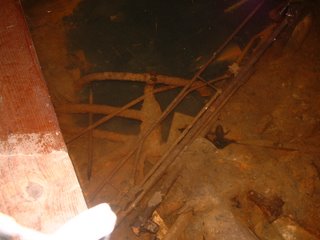 What is this stuff just under the water? That little frog hopped into the water and made me scream like a little girl. It's much deeper than I had thought it was. Eeewwwww!
What is this stuff just under the water? That little frog hopped into the water and made me scream like a little girl. It's much deeper than I had thought it was. Eeewwwww!
The kitten had somehow crossed the water to a mudbar that I couldn't - and didn't want to - reach. She was doing a scared-cat meow, and I could see that she had walked through the bright orange-reddish ooze. Was her fur and flesh burning off at this very moment? Did I pluck her from her cozy barn to bring her to her death just under one hour later? I was scared and creeped out, but I had to save her. She was not about to walk through water again even if it was the only way out of this place. I had to do it myself.

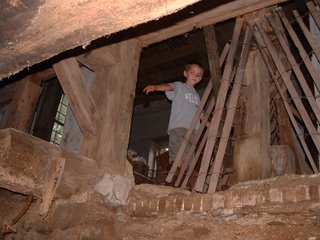 Here's Asa at the top of the race.
Here's Asa at the top of the race.
 Above the grass you can just barely see the top of the stone archway that once allowed a stream to run under the mill. There is a small opening just big enough for critters to crawl into the cavern.
Above the grass you can just barely see the top of the stone archway that once allowed a stream to run under the mill. There is a small opening just big enough for critters to crawl into the cavern.I was relieved that Millie was finally out, and proud of myself for getting the job done. I was absolutely sure that I'd have nightmares that night about the whole fiasco. But I didn't. John took the news about the cats better than I had expected, probably because I rolled into the cat news the story of the horrible experience I had saving her from "under there". We both sat down outside and drank a beer together and talked about our future goals and ideas for our little place with the goats and the kittens and the kids. That day had really turned out pretty nice in the end.
